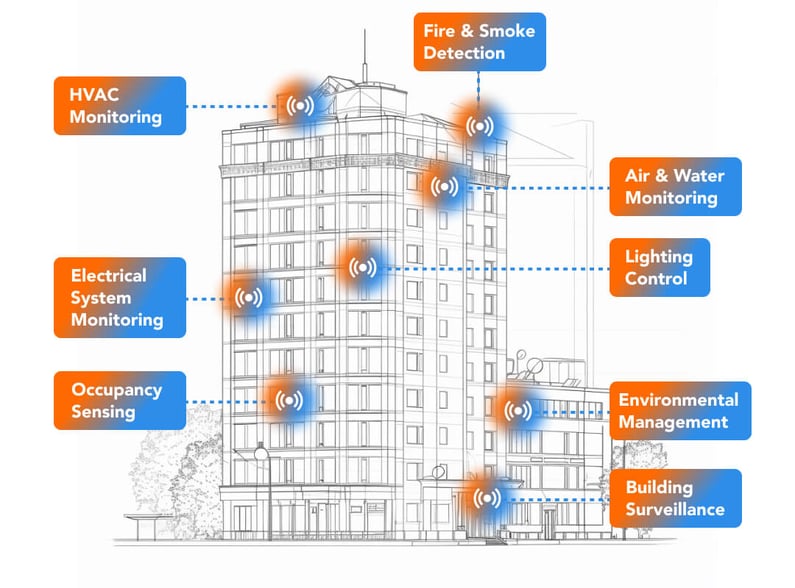The advent of the Internet of Things (IoT) has revolutionized the management and control of building functions. Through the use of interconnected devices, sensors, and data analytics, these systems have paved the way for smart and efficient buildings that prioritize occupant comfort, reduce energy consumption, and optimize operational efficiency.
Connectivity and Device Integration
Smart building automation systems rely on a network of connected devices and sensors that communicate with each other and a central control system. These devices can include HVAC (Heating, Ventilation, and Air Conditioning) systems, lighting systems, access control systems, fire alarms, occupancy sensors, and more. The integration of these devices allows for seamless interoperability, ensuring a holistic approach to building automation.
Modern IoT protocols like MQTT (Message Queuing Telemetry Transport) and CoAP (Constrained Application Protocol) facilitate efficient and lightweight communication between devices. Additionally, interoperability standards like BACnet (Building Automation and Control Networks) and LonWorks enable devices from different manufacturers to work together seamlessly.
Data Collection, Analysis, and Artificial Intelligence
One major advantage of IoT building automation systems is their ability to gather large amounts of data from sensors placed throughout the building. These sensors accumulate data on various parameters such as temperature, humidity, occupancy, energy consumption, air quality, and more.
The central control system receives the collected data and analyzes it in real time for monitoring purposes. Building automation systems use advanced analytics and machine learning techniques to actively identify patterns, anomalies, and correlations within the collected data. With the help of artificial intelligence algorithms, the system can make intelligent decisions and predictions to optimize building operations.
Remote Monitoring and Control for Efficient Building Management
IoT building management systems enable remote monitoring and control. Facility managers and operators can access and manage building functions from anywhere, using a dashboard or mobile app. This remote access allows for real-time monitoring, swift response to issues, and proactive maintenance.
For example, an abnormal increase in energy consumption is detected in a particular area of the building. The system sends an alert to the facility manager, who then remotely adjusts settings or investigates the issue further. Real-time energy monitoring dashboards can provide visibility into energy usage patterns, allowing for strategic decision-making to optimize consumption.
Energy Efficiency and Sustainability
Building automation systems play a crucial role in energy efficiency and sustainability. IoT systems monitor and control factors that affect energy use, like lighting, HVAC, and equipment operation, in real time.
By using occupancy sensors and smart algorithms, managers can effect lighting control according to how many people are present. This means that lights will only be turned on in areas where people are, which helps to save energy and reduce costs. Similarly, HVAC systems can adjust temperature and ventilation based on occupancy and environmental conditions, saving significant amounts of energy.
Additionally, building automation systems can integrate with renewable energy sources and smart grids. It allows for optimal utilization of alternative energy sources and participation in demand response programs. This integration helps shift energy consumption to low-demand periods, reducing strain on the grid during peak hours.
Enhanced Comfort and Occupant Experience
IoT-powered building automation systems prioritize occupant comfort and experience. By utilizing occupancy sensors and data analytics, these systems can automatically adjust temperature, lighting, and ventilation based on occupant presence, preferences, and comfort levels.
For example, as occupants move throughout the building, sensors detect their presence and adjust the room's HVAC settings accordingly. Automated blinds and lighting systems can adjust natural light and brightness levels as per the occupants' preferences, creating a comfortable and productive environment.
Furthermore, IoT building systems let users personalize their workspace environment to suit their needs, giving them control over their surroundings. This level of customization improves job satisfaction and productivity.
Predictive Maintenance and Asset Management
By capturing and analyzing data from sensors and devices, building systems facilitate predictive maintenance and asset management. The system can monitor equipment health, track performance data, and detect anomalies that may indicate potential issues or failures.
Advanced machine learning algorithms can learn the normal behavior of equipment and identify any deviations from expected patterns. Predictive maintenance algorithms can then generate alerts for maintenance teams, prompting them to perform preventive maintenance tasks before equipment failure occurs. This proactive approach reduces downtime, extends equipment life, and minimizes maintenance costs.
Safety and Security
IoT-powered building automation systems bolster safety and security measures in buildings. Integration with security systems, access control systems, and CCTV cameras allows for centralized management of these systems. Real-time alerts enable prompt response to security breaches or safety hazards.
Additionally, IoT sensors can monitor air quality, fire, and smoke detection, enabling early detection and mitigating potential risks. Furthermore, systems can streamline emergency response procedures by automatically triggering alarms, notifications, and evacuation protocols in the event of an emergency.

Scalability and Flexibility
IoT-powered building automation systems are designed with scalability in mind. Organizations can start with basic automation capabilities and expand gradually, integrating additional devices and functionalities according to their evolving needs and budget. The flexibility of these systems allows for easy integration with legacy systems, ensuring a smooth transition to IoT-powered automation.
Building automation systems can utilize cloud platforms for efficiently managing large volumes of data. These platforms offer organizations the essential resources for computing power, storage, and analytics capabilities.
Integration with Smart Cities and Grids
IoT-powered building automation systems can be integrated into broader smart city initiatives and participate in smart grid programs. For example, commercial buildings can use smart grids to manage their energy use. This helps balance the energy demand and reduces stress on the grid during busy times.
Additionally, building automation systems can team up with other city systems like traffic control, waste management, and environmental management. This partnership aims to create a sustainable and connected urban environment.
Challenges to Consider
While IoT-powered building automation systems offer numerous benefits, there are a few challenges to consider. Data security and privacy concerns are paramount, as interconnected devices are susceptible to cyber threats. Robust security measures like encryption, access controls, and regular updates must be implemented to protect sensitive data and prevent unauthorized access.
Interoperability between devices from different manufacturers and protocols may pose challenges during integration. To ensure seamless communication, organizations should opt for devices and systems that comply with industry standards, ensuring compatibility and interoperability.
Reliability and redundancy must also be considered when implementing IoT-powered building automation systems. Backup systems and failover processes should be in place to mitigate the risk of system failures and ensure continuous operations.
IoT-powered building automation systems pave the way for intelligent and sustainable buildings. These systems utilize connectivity, data analytics, and automation to achieve multiple benefits. They save energy, improve occupant comfort, enhance work efficiency, and contribute to environmental preservation.
With continuous advancements in technology, the potential of IoT-powered building automation systems is boundless. As buildings become smarter, more adaptive, and interconnected, the benefits will extend beyond individual structures, impacting entire cities and urban ecosystems. The future of smart buildings lies in embracing IoT-driven innovation and leveraging data to create intelligent and sustainable spaces for the benefit of occupants, organizations, and the environment as a whole.
Failover Solution from POND IoT
At POND IoT, we understand the importance of stable connectivity and offer a robust cellular backup Internet connection. Our 5G Failover solution offers coverage from the three largest nationwide networks on a single SIM and profile.
POND SMART SIM cards improve network signal availability. These Multi-Carriers SIM cards can connect to multiple service providers, automatically switching to alternative networks if the primary one is weak or unavailable. This ensures uninterrupted communication and access to mobile services.
In terms of security, multi-IMSI SIM cards prioritize data protection and secure communication. They incorporate authentication and encryption protocols to safeguard IoT data and facilitate secure connections between devices and the network. By using our SMART SIMs, IoT deployments benefit from enhanced data privacy, authentication mechanisms, and secure network connections, mitigating potential security risks and ensuring the integrity of transmitted information.
Contact us to learn more about our solution.

